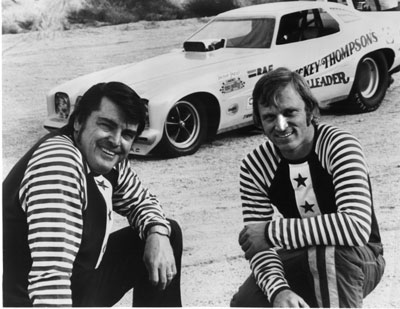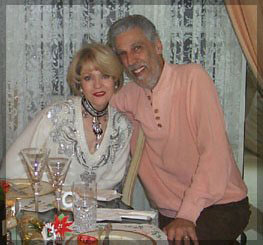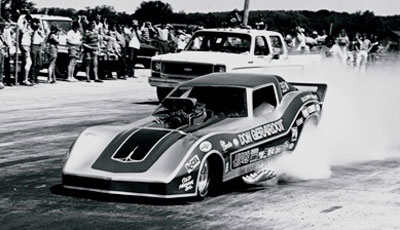

Running up the ol' phone bill
I devoted most of yesterday to trying to make some of the phone calls I mentioned in the column a week ago and trying to at least touch base with some of the people I've yet to reach but have promised myself I would.

Mickey Thompson, Butch Maas, and the Revelleader Grand Am
|
Minding my own cues from Tuesday's missive about time working against us, my first call was to Butch Maas, who's battling some pretty serious health issues. Maas and I spoke more than a year ago when I called to ask about his tenure behind the wheel of the Hawaiian for the article I was writing about the merry-go-round that was the cockpit of Roland Leong's car. He had an amazing career, both in Top Fuel and Funny Car, and drove for the likes of Mickey Thompson, Don Garlits, and Don Prudhomme, which is interesting in itself because you don’t really picture the latter two guys as just handing their car to anyone, but they did to Maas.
I also wanted to talk to Maas about the car he once called his favorite ride – and it's also one of my favorite cars – Thompson's unique Grand Am. Maas' time in the car was rather short yet spectacular – low qualifier at the 1973 Winternationals and a serious fire at the Gatornationals – and just part of the weird (some might say "jinxed") legacy of this car.
 |
I couldn't get Butch on the line, so I instead called the guy who built that body for Thompson, Ron Pellegrini, whose Chicago-based company, Fiberglass Ltd., was the first to mass-produce fiberglass-replica bodies in the earliest days of the glass. Pellegrini's own altered-wheelbase Mustang, the Super Mustang, was the sport's first true fiberglass-bodied Funny Car and led directly to the founding of Fiberglass Ltd. It's an interesting tale, one that I'll share here in the weeks ahead.
The main reason for calling Pellegrini was to get his recount of the founding of the International Funny Car Association, which I first showed off here a few weeks ago with photos sent by Jim Farnsworth. Pellegrini was in on the ground floor of the founding of IFCA, so I wanted to hear his story about the circuit and what happened to it, which you can read below.
While waiting for Maas to return my call, I also tracked down Dale Pulde for his insight into the Thompson Grand Am; Pulde and then crew chief Steve Montrelli had actually put the car together (and ran it at Lions' Last Drag Race in December 1972) before Maas replaced Pulde in the car for the 1973 opener. Pulde, who ended up back behind the wheel a few months later after Maas' horrific fire at the Gatornationals, had a great recall of the details behind the car's many incarnations and drivers, which I'll share when I do that article.
I also dropped an e-mail to Larry "Kingfish" Arnold, who briefly drove the Grand Am, and tracked down a number for Bob Pickett, who was the car's final driver. I plan to talk to both of them within the week and hope to write the story shortly thereafter. Whew.
OK, so on to Pellegrini and IFCA, then some feedback and more injected Funny Car pics to close the week.


Today: Ron Pellegrini and his wife, Adele
|
The International Funny Car Association was an offshoot of the Midwest United Drag Racers Association. To backtrack quickly, UDRA was formed in 1964 – and led by Tom McEwen – as a sort of a racers' rights body, pushing for increased purses and increased safety. Despite the diligence of NHRA and AHRA, a lot of drivers were getting hurt and even killed in the sport's experimental early years, and UDRA pushed for even more stringent rules. Although founded in Southern California, other chapters quickly popped up across the country.
Originally formed as the Chicago chapter of UDRA, the Midwest UDRA was incorporated in 1966 with founding members that included Pellegrini, Joe Turek (its first president), Ed Rachansky (its second leader), John McReynolds, John Farkonas, Pat Minick, Gary Dyer, and others.
"We decided to create some circuits within the UDRA to raise money for the association, and because I was making Funny Car bodies at the time, I became the director of the Funny Car circuits," he said. "Our Funny Car circuits got real popular, more so than the others; we'd have at least two dates every weekend, and the others might have four or five a year. We were so popular that we had to start booking us outside of the Chicago area to allow some of the other circuits to get more bookings, sometimes 300 to 400 miles out. Everybody had a real job, and the travel was too much, so they came to me and said, 'We don’t want to travel anymore,' and asked if we could form our own association outside of the Midwest UDRA. That's when I started the International Funny Car Association. We ran for three or four years with the injected cars before we switched over to blown on alcohol.
"We had it so fine-tuned that Bob Daniels, who was the Division 3 director, later came to me to form a new circuit, NHRA Pro Am lll, that he wanted to use as a prototype within NHRA for doing it with other classes as well. We ran that in 1976-77, and I served as circuit director. We must have had 30 cars at the time, and some big names, too. Frank Hawley was part of it, Dick Titsworth, Don Gerardot, Marlis Williams, Freddie Hagen, Bob Gottschalk, Vern Moats, and so many others. Dale Armstrong even ran a few times.
"The fans loved us because, honestly, the cars ran and sounded good, and we were the main show; they didn’t have anything to compare us to. The Coke circuit [blown nitro Funny Cars in the Coca-Cola Cavalcade of Stars] was running at the time but not really in our area."
Pellegrini, who as mentioned earlier competed in Funny Car, never drove in these series, though he did own a few cars that did, and he'd turn the body and chassis over to teams to run with their own engines.
Coincidentally, I received an e-mail from former Division 3 photographer Richard Brady, who served as the photographer for the Pro Am III circuit.
"Pellegrini had been learning to fly a helicopter, so it was decided that Pellegrini would fly from Chicago down to Indianapolis (where I was living at this time) to get me, and off we'd go to the first two events so he could run the races and I could capture on film the cars of this newly formed circuit. On the appointed day, Pellegrini and his pilot trainer and his wife landed at the small airport of Eagle Creek near IRP, where they stopped long enough to get me, my suitcase, and the huge black, metal camera case with all my Pentax 6x7 cameras, and off we went.

Don Gerardot, at Anonymous Raceway Park
|
"I was the lucky one selected to be the photographer of record for this circuit along with doing a story from each of the races held and to get it published in National DRAGSTER. I should also point out that I was the official Division 3 photographer doing all the Division 3 points meets and as many of the major NHRA events that I could get to, so I was asked by Daniels to go to the first two or three of these events to get the photography but that I was to shoot all the cars without getting any track towers or structures in the background of my shots. This way, for those events I wasn't going to be at -- which was pretty much all of them after the first two or three -- I could pull a negative of the winner and along with my story of the race itself get it in the Wednesday mail and on its way to DRAGSTER! I was to be paid a whole $75 for each of these race stories, which at the time seemed like I had won a small lottery. If you go back and look at those stories that were printed, if the same car won, it was the same photo that was run no matter the facility! To break it up, I'd throw in other action of other cars besides the winner, but unless you knew the tracks, the circuit got its stories run, and not many were wise to it."

Feedback Friday: Regular Insider contributor Cliff Morgan agreed with my assessment of this column's unexpected role in expanding the history of the sport by filling in the blanks. "I think you're dead-on with what you're doing," he wrote. "People have come out of the woodwork with stories, both racers and spectators, and it really gives a new perspective to what has happened over the years. It's like we're all writing history for future generations. I think the only thing I haven't seen much of is stuff from the beginning, like early '50s. I know that we're losing a lot of folks from that era, and what they did laid the foundation for what we have today.
"On a side note, Jeff Foulk wondered how the injected nitro floppers would have evolved if the class had stayed around. Sometimes I have a fantasy of what drag racing would be like with no blowers. If the Top Fuelers and Funny Cars of today had to run injected, how fast would they go? I'm thinking that even with 500-inch motors, Top Fuel would be in the 4.80s and knocking on the door of 300 mph, and the Funny Cars would be, say, two- to three-tenths slower and maybe 5- to 10-mph slower in speed. Of course, if I really go nuts, I can imagine "Pro Mod" Top Fuel and Funny Car, i.e., 900-cid motors with nitrous and nitro. I don't think those cars would be too much slower than the nitro cars that run now. Interesting to think of what a combination like that would do. That would be Jeff Foulk's ultimate injected Funny Car -- what a monster that would be!"
John Leonard had an additional comment about Dan Glover's ex-Wonder Wagon machine; I haven’t been able to verify his claim but find it interesting nonetheless. "The Wonder Wagon Funny Car actually started its life as the second Midnight Skulker Funny Car that Ray Zeller had John Buterra build," he explained. "Ray only ran the car a couple of times with Stan Shiroma driving it. The money man that paid for it got in a fight with Ray and pulled out of funding the car. He (the money man) sold the car back to John Buttera, and he in turn sold it to Don Schumacher, and that's when it became the Wonder Wagon."
And, finally, for your viewing enjoyment, a slew of injected Funny Car photos from the prolific Bob Snyder, circa 1968-69.
 |



















































